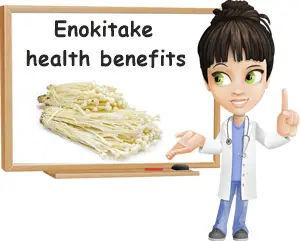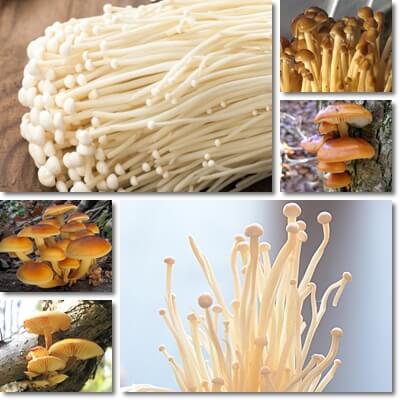Enoki, enokidake or enokitake, scientifically known as Flammulina velutipes, is a species of edible mushroom. There are actually two forms of the mushroom: a wild-sourced and a commercially cultivated form, but they look so different from one another that you would think they are two entirely different species.
In addition to the appreciation it enjoys as a culinary delicacy, enokitake holds medicinal properties and is a source of rather impressive health benefits. Studies show a protein and a glycoprotein isolated from the mushroom inhibit the proliferation of hepatocellular carcinoma and leukemia cancer cells, while water extracts of the species are being researched for breast cancer treatment due to their anti-tumor properties, notably anti-proliferative and apoptosis-inducing effects.
What does enoki mean?
It is one of the common names used to denominate the edible Flammulina velutipes mushroom. It is shorter compared to other names for the species and is derived from the Japanese name for Celtis sinensis (‘enoki’), a species of hackberry tree the mushroom grows on. This species of hackberry tree occurs naturally in Japan, China, Korea, Taiwan and other East Asian countries, its area of distribution overlapping the natural habitat of Flammulina velutipes.

What does enokitake grow on?
Enokitake mushrooms occur naturally in the wild throughout Asia, Europe and North America and grow on several different species of trees, as well as tree stumps and decaying wood. Depending on regional distribution, the edible fungus may be found growing on alder, ash, beech, mulberry, acacia, black locust, persimmon, elderberry and even willow trees, in addition to hackberry.
Commercially farmed enokitake are grown indoors, at low temperatures, in specific substrates, in bottles or other tall and narrow containers and in the absence of light or in low light. These very specific conditions are the reason for the particular appearance of the cultivated form of Flammulina velutipes mushrooms.
What does enokitake look like?
The cultivated version of the Flammulina velutipes mushroom looks quite different from the wild form due to it being grown in low light conditions: clusters of discolored white mushrooms with elongated, thin, almost needle-like stems and disproportionately small, rounded or slightly flattened caps.
There is also a variety of cultivated golden enoki called ‘golden needle mushrooms‘, a name suggestive of its golden-brown color. The wild variety has a more typical mushroom appearance, but stands out as being vividly-colored, with cream and light yellow-brown margins and a yellow-orange, golden-brown, orange-brown or reddish-brown center. You can see how the farmed mushroom looks compared to its wild counterpart in the image below.
What does enokitake taste like?
Mushrooms of the wild variety are savory with a mild flavor intensity and boast slightly nutty and light earthy flavors. The cap is light, meaty, but tender, while the stalks are more fibrous. Farmed enokitake have a much more delicate flavor with a faint fruity aroma, although some find there is barely any taste to them, or smell. When cooked, they can be made either soft and tender or crunchy, depending on the cooking method and usually take on the flavors of the foods they are cooked with or the dishes they are added to.

How to cook enoki mushrooms (the cultivated variety)
Cut the stalks right above where they clump together. Check for freshness and discard slimy or moldy mushrooms. If needed, gently rinse with water to remover any dirt. Enoki mushrooms only require light cooking. For soft, tender, noodle-like enoki, boil the mushrooms for a few minutes or add to a bowl of hot soup and wait for a little while.
If you’re appreciative of their crispness, throw them raw in a salad. For more intense flavor, dry-roast them in a hot pan for a few minutes. For crunch and a beautiful, golden color, stir-fry in oil, pork fat or butter for a couple of minutes. Enoki recipes to try: roasted bacon or beef-wrapped enoki and traditional Japanese hot soups with enoki.
Enokitake nutrition facts
Enokitake nutrition facts presented below serve as a general guideline as to the nutritional profile of the cultivated form of the mushroom species. More or less significant differences in micro and macro-nutrient profile may occur as a result of growing conditions, choice of cooking method, cooking time and other factors.
The best represented nutrients in enokitake are B group vitamins, notably vitamins B1, B2, B3 and B9, iron, phosphorus and potassium, but also dietary fiber. The mushrooms have no essentially no vitamin A, no vitamin B 12, no vitamin C, no vitamin K or E and only trace amounts of vitamin D, calcium, copper, manganese, sodium and selenium.
Nutrition facts per 100 g and per cup (64-65 g):
Energetic value: 37 kcal (kilocalories) per 100 g and 24 kcal per cup
Protein: 2.6 g and 1.7 g per cup
Fat: 0.3 g and 0.2 g per cup
Total carbohydrate: 7.8 g and 5 g per cup
Sugars: 0.2 g and 0.14 g
Dietary fiber: 2.7 g and 1.7 g
Vitamin B1: 0.225 mg per 100 g and 0.144 mg per cup
Vitamin B2: 0.200 mg and 0.128 mg
Vitamin B3: 7 mg and 4.5 mg
Vitamin B6: 0.100 mg and 0.65 mg
Vitamin B9 (folate): 48 mcg (micrograms) and 31 mcg
Iron: 1.15 mg per 100 g and 0.75 mg per cup
Magnesium: 16 mg and 10 mg
Phosphorus: 105 mg and 68 mg
Potassium: 359 mg and 230 mg
Zinc: 0.65 mg and 0.42 mg
Enokitake health benefits
1) Enoki mushrooms are low in calories (24 kcal per cup), making them a good food for losing weight.
2) Contribute to raising energy levels and restore vitality thanks to a good B vitamin and iron content.
3) Source of protein for muscles and carbohydrates for energy.
4) Excellent dietary fiber content with direct benefits for digestive health.
5) Help relieve constipation and regulate transit time for bowel movement regularity.
6) Cholesterol-lowering properties thanks to high dietary fiber content and good content of vitamin B3 (one cup provides around 28% of the recommended daily intake, RDI for an adult).
7) Promote strong bones and teeth thanks to a good phosphorus content (roughly 10% of RDI).
8) Benefits for hypertension: lowers blood pressure numbers thanks to good amounts of potassium (5% of RDI per cup) and no sodium.
9) Anti-thrombotic and blood sugar-lowering properties.
10) Anticancer properties: immune system modulator and anti-tumor, anti-proliferative and apoptosis-inducing agent.
11) Source of ergothioneine, an antioxidant with strong free radical-scavenging activity.
Enokitake mushrooms and cancer
Research has revealed a protein called proflamin isolated from enoki mushrooms stimulates the immune system response by activating T lymphocytes. Studies on mice show ingestion of the protein contributes to improved cancer-fighting properties by activating the immune system and inhibiting tumor growth.
The antitumor properties were tested against melanoma, hepatocellular carcinoma and other cancer cells lines. There is also a hemagglutinin in enokitake mushrooms with anticancer properties, shown to exert an anti-proliferative action against leukemia cells. Another anti-tumor compound in enokitake is flammulin, isolated from the water extract of the mushroom.
Lastly, research is also focusing on enoki mushrooms for their ability to inhibit breast cancer cell proliferation in both estrogen-positive and estrogen-negative breast cancers.
Studies show the water extracts of the mushroom have the potential to induce apoptosis in breast cancer cells and inhibit in vitro tumor formation by up to 99%. Source
Side effects and contraindications
The side effects associated with consumption of enokitake mushrooms may include:
1) Allergic reaction and anaphylactic shock. Although rare, there have been instance of allergic reactions with anaphylactic shock following consumption of the Flammulina velutipes mushrooms, both wild and cultivated forms.
2) Potential source of heavy metals. The wild sourced enokitake mushroom can accumulate heavy metals and toxins such as arsenic from the surrounding environment. The more contaminated the area where the mushroom grows, the higher the chances of it accumulating heavy metals and other toxins.
3) Confusion with inedible or poisonous species. One of the most common wild enokitake look-alikes is Galerina marginata, which is a species of poisonous mushroom. The species contains amatoxins which cause kidney and liver failure. It’s recommended to get your enokitake and other mushrooms from certified sources, whether the supermarket, a health food store or ethnic food store.
